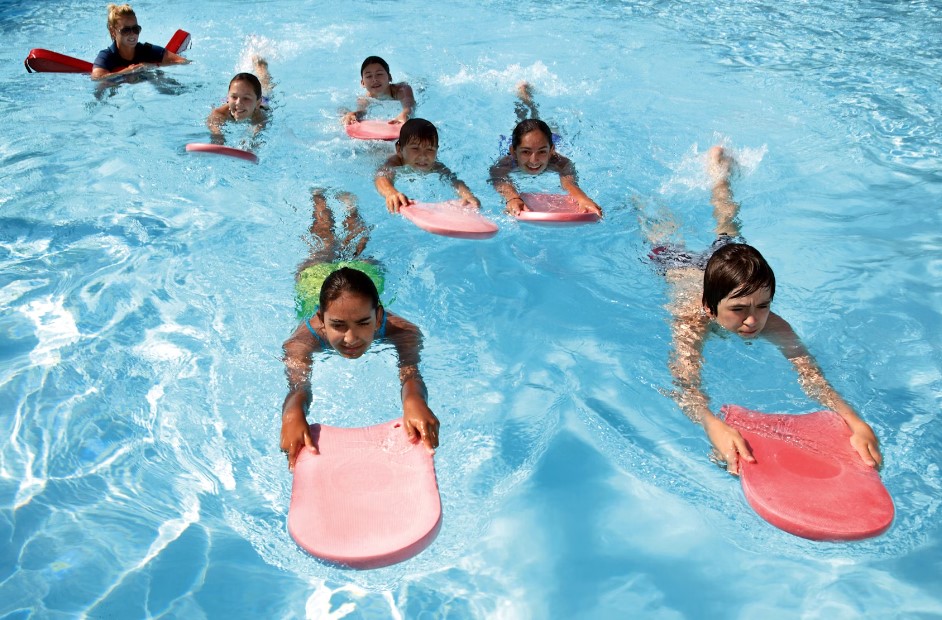Kids should learn to swim because it’s not only fun but also good for their bodies and minds. It works out your whole body and makes you feel better, so it’s fun and good for you. Also, taking swimming classes is a must for making the water safer. Kids learn important safety skills to keep them from drowning, which is one of the main causes of unexpected death.
These lessons teach safety rules and make people aware of them. This is especially important in places where water activities are popular. Starting learning early helps kids remember what they’ve learned, which shows how important water safety habits are for life.
The Vital Role of Teaching Swimming and Water Safety
Teaching swimming and water safety is a very satisfying job that gives people useful life skills and improves heart health through fun water exercises. Many kids are both excited and scared about swimming, which shows how important it is to learn how to swim and feel comfortable in water.
Being comfortable in the water doesn’t always mean you can swim, which shows how dangerous it can be for people who don’t know how to swim. Early swimming lessons are very important for a child’s general development and should get a lot of attention.
For many outdoor activities, knowing how the water works is important, and swimming pools are a safe and good place to learn. In the quiet and supportive environment of a swimming pool, people who are afraid of water can get over their fears. This shows how important it is to learn how to swim early on.
Benefits of Swimming Lessons For Your Kid
Enhancing Water Safety
Water safety is very important, especially since drowning is the main reason kids die. Learning to swim is an important safety measure because it teaches kids how to stay safe in the water, spot dangers, and act quickly in an emergency.
This knowledge not only keeps people alive, but it also gives parents peace of mind when their kids are near water. Additionally, swimming lessons teach useful skills like floating, treading water, and simple rescue techniques that make swimming safer overall.
Fostering Physical Growth
Kids can get a great workout by swimming, which is good for their physical growth. It makes muscles stronger, improves balance, and makes you more flexible. The fun of moving around in water is another reason why it’s appealing. Swimming is great for kids who are more likely to get hurt because it is a low-impact activity.
Elevating Confidence and Self-Worth
Confidence and self-esteem improve a lot when they take water swimming classes for kids. Learning new things makes you feel good about your accomplishments and makes you happy. The thrill of swimming across the pool makes them feel good about themselves, which can affect other parts of their lives and improve their general self-image.
Cultivating Perseverance and Scholarship Prospects
Swimming can be hard, especially for kids who are just starting to learn how to do it. Still, if they work hard and don’t give up, they can get past problems and become more resilient. This toughness helps them have a growth attitude, which makes them more willing to take on challenges in all areas of their lives.
Also, many swimming schools offer scholarships to kids who are good at swimming and work hard at it. This means that kids with skills like Michael Phelps’ could achieve great things.
Nurtures Social and Emotional Development
Kids can hang out with their friends in a fun way during swimming lessons, which can help them make new friends and work together as a team. Besides being fun, these lessons help kids learn important social and emotional skills, such as how to communicate, work with others, and understand others’ feelings. Being able to swim with friends makes the experience even better!
Choosing the Right Swim Program for Children
Look for programs that:
Employ Experienced and Certified Instructors
Ensure that swim instructors are qualified and certified through a nationally recognized learn-to-swim curriculum. Additionally, there should be certified lifeguards on duty with current CPR and First Aid training.
Provide Continuous Learning Opportunities
Choose programs that offer multiple sessions to allow for gradual skill development. Progress should be visible over time, with a focus on mastering basic water competency skills.
Emphasize Good Safety Practices
Children should learn and practice good safety habits in and around water, including never swimming alone and always seeking permission before entering water bodies like lakes. Instructors should instill these habits along with parental supervision.
Offer Trial Classes for Evaluation
Parents should have the opportunity to observe a class before enrolling to assess its suitability. Consider factors like active swimming time, individual attention, and instructor expertise.
Teach Water Survival Skills
Lessons should cover what to do if unexpectedly in the water, including self-rescue techniques. Realistic scenarios like swimming clothed should be part of the training. Older children should also learn how to assist others in distress and seek help.
Supervising Children in and Around Water: Best Practices
Effective Supervision Strategies
Ensure proper supervision in and near water, as it is crucial for preventing drowning incidents. Stay focused and avoid distractions, especially when supervising young children or weak swimmers.
Alcohol and Drug Avoidance
Refrain from alcohol or drug use when supervising others around water, as impaired judgment can compromise safety.
In-Water Supervision
For young children or inexperienced swimmers, accompany them in the water and maintain “touch supervision” to keep them within arm’s reach at all times.
Avoid Leaving Children Unattended
Never leave babies or young children near water without direct adult supervision, and avoid relying on older children to watch younger ones.
Emergency Preparedness
Familiarize yourself with recognizing distress signs and knowing how to respond in case of trouble. CPR and rescue technique training are essential for everyone involved in water activities, making water safety a collective family effort.
Assign Water Watchers
During gatherings near water, designate a “water watcher” whose sole responsibility is to keep a constant eye on children in or near water, rotating responsibilities among adults periodically.
Risk Awareness
Be mindful that toddlers aged 1-4 are at high risk of drowning due to unsupervised access to water during non-swim times, emphasizing the need for vigilant supervision.
Consider Swimming Lessons For Your Child!
Taking swim classes for kids is good for both the kids and the parents in many ways. Kids learn to swim faster and easier than adults do, which makes it safer for them to do things in the water. Seeing how well your child can swim gives you confidence and happiness, which makes summers and family trips more fun and stress-free.



